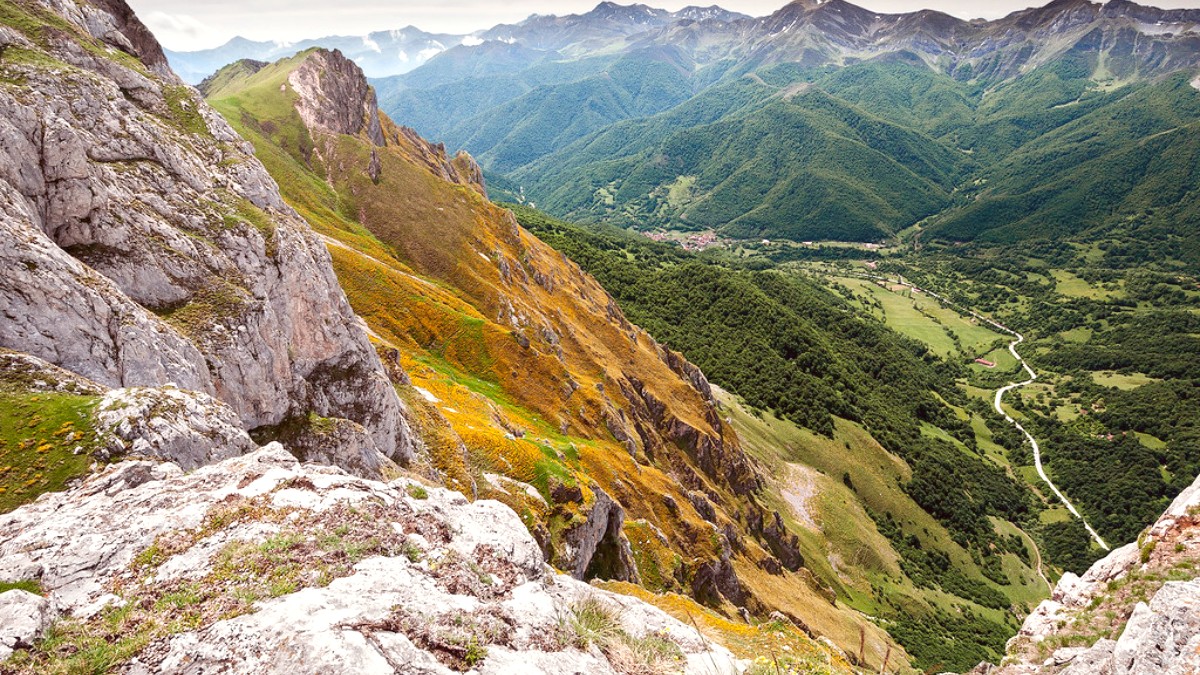
Spain
The Lakes of Covadonga, Enol and Ercina, offer stunning natural spectacles with rolling green pastures and dramatic peaks. The Sanctuary of Covadonga holds deep historical and religious significance, commemorating the Battle of Covadonga.
The Fuente Dé Cable Car in Cantabria offers a dramatic ascent into the high mountains for immediate panoramic views. Bulnes Village provides a look at traditional mountain life, accessible by funicular or challenging trail. Naranjo de Bulnes is an iconic peak for experienced climbers.
Using a guide can enhance your experience and ensure safety, especially on challenging routes.
A medieval old town with narrow streets, stone houses, and the Torre del Infantado.
Features the iconic Roman Bridge (Puente Romano) over the Sella River.
Explore Bulnes, Mogrovejo, or Tielve for preserved stone architecture and traditional granaries (Hórreos).
A significant pilgrimage site near Potes, housing a piece of the True Cross.
Surrounding Asturian region holds mining history, with old operations visible.
The Picos de Europa National Park itself is a prime natural attraction, showing spectacular landscapes and diverse ecosystems.
Breathtaking views over the Central Massif and glacial valleys.
Upper cable car station offers immediate panoramic high-mountain views.
A spectacular, deeply carved gorge with a famous trail along its cliffs.
Spot Cantabrian chamois, various deer species, and diverse birdlife (vultures, eagles).
Rare sightings of Cantabrian brown bears or wolves are possible with patience.
Dawn and dusk are optimal for wildlife observation. Maintain distance.
The Picos de Europa is a National Park, protecting unique ecosystems. Other natural parks surround the core area.
A prime example of limestone karst topography, with dramatic cliffs, deep gorges, vast cave systems, and glacial valleys.
The Deva, Sella, and Cares rivers create stunning gorges and are excellent for fishing (with license) and white-water sports.
Picos de Europa offers off-the-beaten-path experiences for those seeking less crowded adventures.
Beyond the famous sites, Picos de Europa's rich history and diverse natural elements are worth exploring.
Remnants of ancient mining operations and pastoral enclosures scatter the landscape. For unique art exhibitions, larger cities surrounding the park are a better option. Local cultural centers may host regional history or art displays.
The surrounding Asturian region has a strong industrial past, specifically in mining. Old mining operations and their infrastructure are available for exploration.
While not within the park, the beautiful Asturian and Cantabrian coasts are a short drive away, offering stunning beaches and dramatic cliffs.
Capture the essence of Picos de Europa beyond its main landmarks with these photo ideas.
Explore quieter corners for a more secluded Picos de Europa experience.
Picos de Europa's highlights span natural beauty, historical depth, and cultural insights.
Lakes of Covadonga, Fuente Dé Cable Car, and the dramatic Cares Gorge showcase the park's geological splendor.
Sanctuary of Covadonga and medieval towns like Potes connect you with the region's rich past.
Discover less-traveled paths and local favorites for a , more intimate exploration of the landscape.
A historical and natural must-see, combining religious heritage with glacial lakes.
Find nearby staysQuick access to high-altitude panoramic views and hiking trails.
Book your ticketsExplore narrow streets, historic buildings, and local markets in the eastern Picos.
Discover local hotelsExperience a traditional isolated village accessible by an underground funicular.
Search nearby hostelsA quieter, remote side of the park with charming villages and less crowded trails.
Find vacation rentalsGain insights into the region's heritage and natural environment at specialized museums.
Experience the spiritual side of Picos de Europa at its revered sites.
When planning your visits, consider grouping nearby attractions to optimize your time.
For example, combine Covadonga Lakes and Sanctuary in one day, or Fuente Dé with exploration of the Liebana Valley.
While Picos de Europa is known for its mountains, the nearby coast and rivers offer distinct natural beauty and activities.
The Asturian and Cantabrian coasts, a short drive from the park, feature stunning beaches and dramatic cliffs.
The Deva, Sella, and Cares rivers carve stunning gorges and offer various water-based activities.
Picos de Europa's geology showcases dramatic limestone karst topography, shaped by natural processes.
These formations provide an unique landscape for exploration and study.
As a designated National Park, Picos de Europa actively protects its unique ecosystems and diverse flora.
Conservation efforts preserve this natural heritage for future generations.
Connecting with locals can open doors to lesser-known attractions and unique experiences.
These discoveries create a more personal and memorable journey.
Many sites are intertwined with local traditions, from historical events to current community practices.
Efforts preserve the natural and cultural heritage of the Picos de Europa for generations.
Park visitor centers offer comprehensive information on geology, flora, fauna, and cultural heritage.